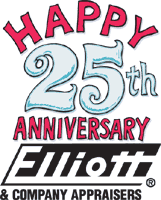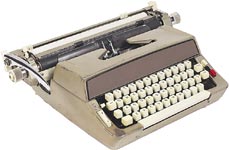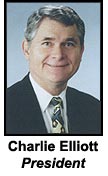|
 |
| October 2005 |
A Publication of ELLIOTT®
& Company Appraisers |
|
|
 |
|
|
|
ELLIOTT®
& COMPANY APPRAISERS
CELEBRATES 25 YEARS IN BUSINESS |
|
|
 On
October 1, ELLIOTT® & Company Appraisers celebrated the 25th
anniversary of its founding. During its quarter century of business,
ELLIOTT® has grown, through a combination of technological
innovation and personal service, into one of the country's best
known and reliable appraisal management companies. On
October 1, ELLIOTT® & Company Appraisers celebrated the 25th
anniversary of its founding. During its quarter century of business,
ELLIOTT® has grown, through a combination of technological
innovation and personal service, into one of the country's best
known and reliable appraisal management companies.
"We have access to, and employ, the best appraisal technology
available, but we really take pride in our personal service," said
Charlie Elliott, president of ELLIOTT® & Company Appraisers.
"I believe that our service sets us apart from other
appraisal-management companies. We have live people available to
handle our clients’ needs. We have electronic systems that are
designed to make the appraisal-ordering process seamless, however,
our product is not one that can be delivered exclusively through
electronic media. Our people are more than just order-takers;
they’re problem-solvers."
ELLIOTT® offers appraisal service in all counties in all 50 states.
In addition to appraisal services, the company performs property
inspections, construction inspections and appraisal reviews. It
offers a complete line of risk management services, including
consulting.
ELLIOTT® & Company Appraisers currently has a network of
approximately 3,000 appraisers to serve the needs of over 4,000
clients. The company does business with virtually every major bank
and mortgage lender in the United States, including many
foreign-owned institutions.
For several years now, ELLIOTT® & Company Appraisers has had an
electronic order-processing system, where the progress and status of
an order can be checked seven days a week, 24 hours per day, through
the company's Web site. The company continues to look for innovative
ways to service its clients and streamline the appraisal process.
One of the latest innovations is a proprietary Web-based
construction-draw inspection-report system, which gives the company
a standard professional product to offer its clients, allowing them
to populate their electronic systems automatically with the
inspector's report without using data-entry labor.
The world has changed a lot since 1980, and the world of appraising
has seen its share of change. ELLIOTT® & Company Appraisers will
continue to strive to make positive change through innovation in the
future. But never will the company lose sight of the importance of
good, old-fashioned personal service.
|
|
|
MUCH HAS CHANGED IN THE
APPRAISAL BUSINESS
IN THE LAST 25 YEARS |
|
The environment for real estate appraisers
is completely different from what it was when ELLIOTT® & Company
Appraisers was founded 25 years ago.
 In
1980 there was no law requiring official government approval for one to
become a real estate appraiser. The standard that most lenders looked
for in an appraiser was a designation from a respected organization,
such as the American Institute of Appraisals or the Society of Real
Estate Appraisers, who have since merged to become the Appraisal
Institute. People earned these designations by taking courses and
gaining supervised appraisal experience, which was the rough equivalent
to what certification is today. Some complained that these organizations
made it too difficult for qualified individuals to get designations.
That changed about 1990 when appraisal certification began. Many, who
hadn’t been able to get designations, became certified. This shifted
power from the appraisal organizations to the government. States now
license and discipline appraisers and the Appraisal Foundation,
established around the same time, monitors and scrutinizes the
processing phase of appraising. In
1980 there was no law requiring official government approval for one to
become a real estate appraiser. The standard that most lenders looked
for in an appraiser was a designation from a respected organization,
such as the American Institute of Appraisals or the Society of Real
Estate Appraisers, who have since merged to become the Appraisal
Institute. People earned these designations by taking courses and
gaining supervised appraisal experience, which was the rough equivalent
to what certification is today. Some complained that these organizations
made it too difficult for qualified individuals to get designations.
That changed about 1990 when appraisal certification began. Many, who
hadn’t been able to get designations, became certified. This shifted
power from the appraisal organizations to the government. States now
license and discipline appraisers and the Appraisal Foundation,
established around the same time, monitors and scrutinizes the
processing phase of appraising.
The appraisal forms in 1980 looked a lot like they do today, but there
is not a line on them that hasn’t changed since then. There are now many
more types of appraisal forms. The completion process of them is nothing
at all like it was 25 years ago, when the forms were completed on a
typewriter. They came on a pad, to be torn off, one at a time. Later
continuous forms became available, along with the corresponding
software, which allowed appraisers to fill out the forms on a computer
and run them off on the printer. The process has again evolved to the
point where the forms are imbedded in the software.
Photographs were required with an appraisal in 1980 but the standard
back then consisted of four Polaroid snapshots, which were glued to the
back of the form. When one-hour photo shops became common, the
35-millimeter camera became standard appraisal equipment. Once digital
cameras became available, they became the standard, which appraisers
adhere to today.
With the advent of digital photos, it was possible to e-mail the entire
appraisal. But only a small percentage of lenders had the equipment
necessary to receive e-mail and to manage it in a way they could get
their appraisals out of it. That changed in 2000, when our work went
from being sent out 90% hard copy to 90% sent out electronically within
a period of 12 months. Very few appraisals are sent out in hard copy
form today.
The rise of appraisal management companies has become a major factor in
the growth of ELLIOTT®. In 1980 very few of these companies existed and
most of them were unable to command much respect. Most lenders
considered the quality of work performed by an individual appraiser to
be, on the whole, of higher quality than that done through a management
company. Most banks didn’t give much appraisal business to management
companies because they had a reputation of not being very choosey with
whom they would hire to perform an appraisal. Today, however, many major
banks actually own appraisal management companies, normally for the
purpose in getting their own potential collateral appraised. The
percentage of appraisals done through management companies has grown
dramatically in recent years and probably will continue to increase. One
reason is that management companies offer the likelihood of an appraisal
being prepared more independently. This would lessen the likelihood of fraud
in the appraisal process.
prepared more independently. This would lessen the likelihood of fraud
in the appraisal process.
In 1980 appraisers almost always worked out of offices outside of their
home. Due to appraisal certification and more advanced technology, a
high percentage of appraisers now operate independently from their
homes. This helps management companies. There is an ample supply of
qualified appraisers, throughout the country, who do not have much of a
promotional budget or aptitude, but are available to work efficiently
and hold their costs down, providing appraisals at lower prices.
ELLIOTT® & Company Appraisers has survived the last 25 years by adapting
to and taking advantage of the changes in the industry and plans to
continue doing so in the years ahead.
|
|
|
|
PRESIDENT'S COMMENTS |
|
Twenty-Five
Years and No Secrets
 When
our company was founded 25 years ago, I never thought about the
possibility of a silver anniversary. I had confidence in our
ability to succeed, but there were more important things to
think about, like where the clients were going to come from and
what staff would be delivering the service. When
our company was founded 25 years ago, I never thought about the
possibility of a silver anniversary. I had confidence in our
ability to succeed, but there were more important things to
think about, like where the clients were going to come from and
what staff would be delivering the service.
The past quarter of a century has not been free of challenges.
While we've never been confronted with critical issues, which
represented a threat to the existence of the company, the
challenges have been more of the everyday variety.
I once heard a businessman, for whom I have much respect, asked,
"John, you have always been so darned successful. What is your
secret?"
John looked up with a confident smile, taking the time to
reflect the wisdom he had garnered over the years, and said,
"The secret to success in business is that there is no secret.
It is not one or two critical issues that we focus on. Rather it
is all of the little things that we do every day, that has made
us successful."
ELLIOTT® & Company Appraisers, by many standards, would be
considered a medium-sized company, larger than many of our
competitors, yet smaller than others. Perhaps, that has been a
blessing. Our size has allowed us to grow slowly but surely,
taking care of those little responsibilities that John speaks of
on a daily basis. In baseball jargon I would say that we have
not based our business on home runs but on singles. Examples of
these hits are personally answering our telephone, solving
problems with our clients, calling and thanking clients for
their business and attempting to insure that each client is
satisfied with each transaction.
We give a hats-off thank you, to all of our clients who have
made the last 25 years possible. You have been understanding,
forgiving, patient, generous and, most of all, a lot of fun to
work with. For this we salute you and ask you for the
opportunity to shoot for another milestone, the golden
anniversary. |
|
|
|
WHAT ELSE WAS
HAPPENING IN OCTOBER 1980 |
-
 President
Jimmy Carter was in the final month of his reelection
campaign against former California Gov. Ronald Reagan.
Reagan went on to win that election and the Republicans took
control of the U.S. Senate for the first time in 26 years. President
Jimmy Carter was in the final month of his reelection
campaign against former California Gov. Ronald Reagan.
Reagan went on to win that election and the Republicans took
control of the U.S. Senate for the first time in 26 years.
- Iranian militants were
holding 52 U.S. Embassy workers hostage in Tehran. The
hostages were finally released the following January after
444 days in captivity.
- War broke out between Iran
and Iraq. Time Magazine referred to Iraq President Saddam
Hussein, 43, as "the Arab world’s newest and most determined
strongman."
- Alexei Kosygin, 76, resigned
as prime minister of the Union of Soviet Socialist
Republics. U.S.S.R. President Leonid Brezhnev nominated
75-year-old Nikolai Tikhonov to take his place. Brezhnev,
73, was reportedly suffering from jaw cancer and heart
disease. The average age of the ruling 15-man Politburo was
69.
- Muhammad Ali, in a bid to
regain boxing’s World Heavyweight Championship, was defeated
by Larry Holmes. It was Ali’s final professional fight.
- The Philadelphia Phillies
led by third baseman Mike Schmidt, first baseman Pete Rose
and pitcher Steve Carlton, won their first (and, so far,
only) World Series.
- Foreign investors owned
control of 77 U.S. banks.
- Mortgage rates were at
14.5%. They had been as high as 17% earlier that year.
- The concept of the great
room, replacing the living room, was getting started.
- Cape Cod type houses in
Boston, with unfinished second floors, were selling for
under $50,000
Fifteen percent of new housing on the market was
condominiums, up from 11.6% the year before.
Promoters of mobile homes were introducing a new term for
their product, "manufactured housing." Thirty thousand of
these were sold in Florida, compared to 14,000 three years
previously. A large, comfortable such unit went for about
$20,000.
- Innovative, new
home-financing plans included graduated payment mortgages,
variable or renegotiable-rate mortgages, share appreciation
mortgages and owner financing.
|
|
|
|
QUOTES FROM OCTOBER
1980 |
|

"There is little short-term
prospect for closing the gap in the housing deficit. We are
starting the decade about 1 million units a year short. We
will have tough years ahead. Marriages will have to be
postponed, and young people will have to double up with
families."
- James Christian, senior economist of the United States
League of Savings Associations.
"During the 1980s a record 42 million people will reach
their 30s, the heaviest house buying years. For many of
them, the detached house in suburbia will be only a fading
mirage." - Time reporter Edward Scharff
"This was the shortest recovery in the history of the
industry."
- Merrill Butler, president of the National Association of
Homebuilders.
"Hallways are the result of lazy architects, and the days of
formal living room and dining room are numbered, except for
the very affluent." -
Daniel Miller, an Orlando, Fla.,
real estate agent
"What (Reagan) would do in the Oval Office I hope will never
be observed." - Jimmy Carter
"I don’t understand why (Carter’s) answer to inflation was
to put 2 million people out of work."
- Ronald Reagan
"Reagan is the unknown evil. Carter is the known evil."
-
Independent presidential candidate John Anderson
"I'm supporting Carter because I don’t want to die."
-
Goldie Hawn
"There have been a lot of been a lot of poor decisions made
in the last four years. We've got to stop the snowball from
going downhill."
-
Roger Staubach
"Regardless of what these tapes say, I didn’t take any
money,"
- U.S. Rep.
John Jenrette, upon his conviction for bribery in wake of
the Abscam scandal
"If you don’t write your own book, someone who has never
been within 100 miles of you will do it from old newspaper
clips." - Gloria Swanson
"Ask George Burns when he’s going to retire."
- Bob Keeshan, who played Captain Kangaroo, on the 25th
anniversary of his show.
|
|
 |









